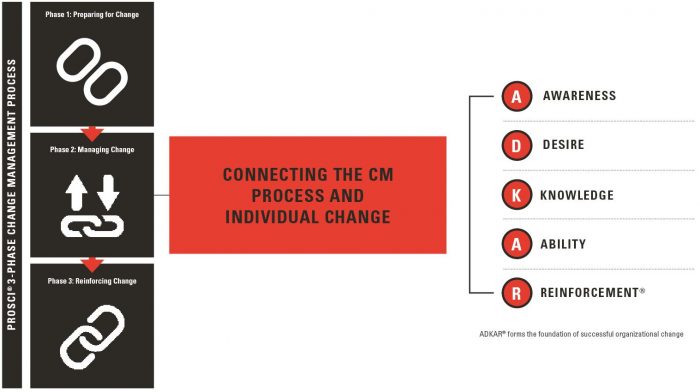With the COVID-19 pandemic, the world is facing and anticipating continuous change now and for the foreseeable future. As our nation begins to reopen, it amplifies the need for organizations to understand the impact of this transitional period, gain accurate knowledge of how to manage change, and establish the ability to reinforce change.
Little’s in-house Prosci Certified Change Practitioners, Rebecca Sistruck and Lindsey Walker, comment on successful change leadership strategies and methodologies amidst the global pandemic. They understand how engaging employees at an individual level improves organizational results and how this approach can be applied to any current or future situation. To help organizations across the country, we’ve asked them to address some important questions and topics below.

WHY IS CHANGE MANAGEMENT SUCH A CRITICAL COMPONENT OF WORKPLACE STRATEGY AND DESIGN ESPECIALLY DURING THE COVID-19 CRISIS?
According to Prosci, an industry-recognized research organization teaching change management skills and methodologies, change management is defined as “the process, tools and techniques to manage the people side of change to achieve the required business results”. The primary driving force of the spaces we design, whether a headquarters, healthcare facility, or retail store, is determined by the human beings who occupy them. Empathetic understanding of individuals’ interactions, relationships, and experiences informs our strategies in day to day projects – particularly in times of uncertainty. To achieve measurable, positive business results, we know the executed strategy and design we develop must make it easy and clear for users to embrace and adopt any changes set forth by what is created. In our current fluid environment, behavioral, policies and space usage change become even more relevant.
The people and the built environment are large investments and influences on an organization’s success. These critical elements are the visual reminders of the values, mission, and potential innovation that exist within an organization. Acknowledging and understanding the impact of the change on the people is imperative to the change management process.
HOW DOES LITTLE APPROACH AND APPLY CHANGE MANAGEMENT WITH CLIENTS?
Little has always taken a human-centered approach to our design process. Our change management approach is no different. Much like the design process, there is a formula for a highly tested change management methodology. By using the Prosci process, we follow a structured 3-phase approach to individual change – (1) Prepare for the change, (2) Manage the change; and (3) Reinforce change.

It is our role to anticipate the opportunities and challenges that both outside influences and workplace transformation may present to individual clients and their employees-at-large. The human experience within the workplace is tied to complex personal and professional experiences and learned behaviors. Along with the Prosci three-phase approach, Little uses our own measurement survey tools and the in-depth Prosci ADKAR project and group assessments. The ADKAR model has five elements: Awareness, Desire, Knowledge, Ability, and Reinforcement. These elements provide the framework used to evaluate change on an individual level.
WHAT ARE THE TOP 3 CHALLENGES WHEN LEADING AND MANAGING CHANGE?
1. Employee engagement is key. Change management is more than creating communication plans or sending “all employee” emails. At its core, it is about employee engagement. Engagement requires connecting at all levels within the organization and with the variety of audiences impacted by the change.
2. Change takes time. Adapting to a new workplace strategy or design will require patience as employees process and become accustomed to the change. There is upfront time needed to carefully craft and hone a change management strategy as well as time needed from leadership to help develop, manage and reinforce the plan. Key business leaders such as HR, IT, internal communications and marketing are critical subject matter experts that should be engaged early and play integral roles throughout the process. Additionally, equipping direct supervisors with resources and knowledge to address employee resistance will empower all individuals and mitigate potential risks.

3. Planning ahead. Planning early allows in-depth assessment of risks and benefits, related to the change that lies ahead. A challenge of change management is developing and implementing a strategy/plan prior to tensions arising that could distract from the overall business goals. If employees are aware of why a change is occurring but do not understand how it affects them personally (Desire) or have the right information (Knowledge), fear and frustration can set in. Providing awareness, opportunities for participation, and knowledge can achieve the desired metrics and vision.
Bonus: Reset & Adjust. Change is just as much about understanding what will stay the same as what will be different. We should always evaluate these two ideas together. When transition continues to occur in very small ways around us without significant disruption, we evolve without even knowing.
The COVID-19 environment reminds us that the information we process and the plans we make will evolve – as will our goals and measurement around change. This time is unique because, globally, we all are sharing in very similar experiences. Being mindful of this allows organizations, leaders, and individuals to continually “reset & adjust” so we can constantly learn from each other and then apply.
Keep a watchful eye out for Part 2: Change Management and the “New Normal” during COVID-19. In the meantime, here is a helpful article on ‘How to Manage Change in a Crisis With No Time to Plan’
Sources:
The Prosci Adkar® Model
Prosci Inc – https://www.prosci.com/adkar
The Global Leader in Change Management Solutions
Prosci Inc – https://www.prosci.com/
How To Manage Change in a Crisis With No Time To Plan

